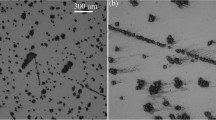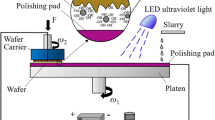Abstract
To realize an efficient and high-quality chemical-mechanical polishing process for the surface of a SiC wafer, a new type of MnO2 slurry is developed employing the multi-valence and oxidation-reduction characteristics of MnO2 particles. This slurry is utilized to polish the Si-face of SiC wafers. In this paper, the influences of the polishing particle concentration and the pH of slurry on MRR are analyzed, the polishing performance of the MnO2 slurry is studied, and the polishing mechanism of the MnO2 slurry on the SiC wafer is determined. The polishing mechanism of the MnO2 slurry is verified by selecting commonly used additives, such as KMnO4, and the influence of the additive amount on the MRR is analyzed. Finally, the surface morphology of the material after polishing is observed with analytical instruments. The experimental results show that the MRR of the MnO2 slurry is highly dependent on the pH value of the slurry. The MnO2 particles tend to convert into MnO4- ions in an alkaline environment, and the strong oxidizing property of MnO4- ions greatly improves the polishing efficiency. As the MnO4- ion concentration increases, the MRR can reach over 600 nm/h, and an ultra-smooth surface with a surface
Similar content being viewed by others
References
Okumura, H., “Present Status and Future Prospect of Widegap Semiconductor High-Power Devices,” Japanese Journal of Applied Physics, Vol. 45, No. 10R, pp. 7565–7586, 2006.
Millan, J., “Wide Band-Gap Power Semiconductor Devices,” IET Circuits, Devices & Systems, Vol. 1, No. 5, pp. 372–379, 2007.
Li, M., Zhou, X., Yang, H., Du, S., and Huang, Q., “The Critical Issues of SiC Materials for Future Nuclear Systems,” Scripta Materialia, Vol. 143, pp. 149–153, 2018.
Agarwal, A. and Haney, S., “Some Critical Materials and Processing Issues in SiC Power Devices,” Journal of Electronic Materials, Vol. 37, No. 5, pp. 646–654, 2008.
Jia, G., Li, B., and Zhang, J., “Influence of SiC Surface Defects on Materials Removal in Atmospheric Pressure Plasma Polishing,” Computational Materials Science, Vol. 146, pp. 26–35, 2018.
Roccaforte, F., Fiorenza, P., Greco, G., Nigro, R. L., Giannazzo, F., et al., “Emerging Trends in Wide Band Gap Semiconductors (SiC and GaN) Technology for Power Devices,” Microelectronic Engineering, Vols. 187–188, pp. 66–77, 2017.
Roccaforte, F., Fiorenza, P., Greco, G., Vivona, M., Nigro, R. L., et al., “Recent Advances on Dielectrics Technology for SiC and GaN Power Devices,” Applied Surface Science, Vol. 301, pp. 9–18, 2014.
Roccaforte, F., Giannazzo, F., Iucolano, F., Eriksson, J., Weng, M., and Raineri, V., “Surface and Interface Issues in Wide Band Gap Semiconductor Electronics,” Applied Surface Science, Vol. 256, No. 19, pp. 5727–5735, 2010.
Yagi, K., Murata, J., Kubota, A., Sano, Y., Hara, H., et al., “Defect-Free Planarization of 4H–SiC (0001) Substrate Using Reference Plate,” Japanese Journal of Applied Physics, Vol. 47, No. 1, pp. 104–107, 2008.
Luo, J. and Dornfeld, D. A., “Material Removal Mechanism in Chemical Mechanical Polishing: Theory and Modeling,” IEEE Transactions on Semiconductor Manufacturing, Vol. 14, No. 2, pp. 112–133, 2001.
Lee, H. and Jeong, H., “Analysis of Removal Mechanism on Oxide CMP Using Mixed Abrasive Slurry,” International Journal of Precision Engineering and Manufacturing, Vol. 16, No. 3, pp. 603–607, 2015.
Lee, D., Lee, H., and Jeong, H., “Slurry Components in Metal Chemical Mechanical Planarization (CMP) Process: A Review,” International Journal of Precision Engineering and Manufacturing, Vol. 17, No. 12, pp. 1751–1762, 2016.
Aida, H., Doi, T., Takeda, H., Katakura, H., Kim, S.-W., et al., “Ultraprecision CMP for Sapphire, GaN, and SiC for Advanced Optoelectronics Materials,” Current Applied Physics, Vol. 12, Suppl. 2, pp. S41–S46, 2012.
Lagudu, U. R. K., Isono, S., Krishnan, S., and Babu, S., “Role of Ionic Strength in Chemical Mechanical Polishing of Silicon Carbide Using Silica Slurries,” Colloids and Surfaces A: Physicochemical and Engineering Aspects, Vol. 445, pp. 119–127, 2014.
Basim, G., Adler, J., Mahajan, U., Singh, R., and Moudgil, B., “Effect of Particle Size of Chemical Mechanical Polishing Slurries for Enhanced Polishing with Minimal Defects,” Journal of the Electrochemical Society, Vol. 147, No. 9, pp. 3523–3528, 2000.
Pan, G., Zhou, Y., Luo, G., Shi, X., Zou, C., and Gong, H., “Chemical Mechanical Polishing (CMP) of On-Axis Si-Face 6H-SiC Wafer for Obtaining Atomically Flat Defect-Free Surface,” Journal of Materials Science: Materials in Electronics, Vol. 24, No. 12, pp. 5040–5047, 2013.
Deng, H., Hosoya, K., Imanishi, Y., Endo, K., and Yamamura, K., “Electro-Chemical Mechanical Polishing of Single-Crystal SiC Using CeO2 Slurry,” Electrochemistry Communications, Vol. 52, pp. 5–8, 2015.
Yamazaki, T., Kurokawa, S., Umezaki, Y., Ohnishi, O., Akagami, Y., et al., “Study on the Development of Resource-Saving High Performance Slurry-Polishing/CMP for Glass Substrates in a Radical Polishing Environment, Using Manganese Oxide Slurry as an Alternative for Ceria Slurry,” Advances in Science and Technology, Vol. 64, pp. 65–70, 2010.
Lee, H. S., Kim, D. I., An, J. H., Lee, H. J., Kim, K. H., and Jeong, H., “Hybrid Polishing Mechanism of Single Crystal SiC Using Mixed Abrasive Slurry (MAS),” CIRP Annals, Vol. 59, No. 1, pp. 333–336, 2010.
Yin, T., Kurokawa, S., Ohnishi, O., Yamazaki, T., Wang, Z. D., and Tan, Z., “The Effects of Strong Oxidizing Slurry and Processing Atmosphere on Double-Sided CMP of SiC Wafer,” Advanced Materials Research, Vols. 591–593, pp. 1131–1134, 2012.
Kurokawa, S., Doi, T., Wang, C. W., Sano, Y., Aida, H., Oyama, K., and Takahashi, K., “Approach to High Efficient CMP for Power Device Substrates,” ECS Transactions, Vol. 60, No. 1, pp. 641–646, 2014.
Kurokawa, S., Doi, T., Ohnishi, O., Yamazaki, T., Tan, Z., and Yin, T., “Characteristics in SiC-CMP using MnO2 Slurry with Strong Oxidant under Different Atmospheric Conditions,” Materials Research Society Symposium Proceedings, Vol. 1560, pp. 39–47, 2013.
Ma, L., Peng, X.-Q., and Dai, Y.-F., “Effect of Fenton-Kind Process in Silicon Carbon Polishing,” Aviation Precision Manufacturing Technology, Vol. 4, No. 12, pp. 2–6, 2012.
An, J. H., Lee, G. S., Lee, W. J., Shin, B. C., Seo, J. D., et al., “Effect of Process Parameters on Material Removal Rate in Chemical Mechanical Polishing of 6H-SiC (0001),” Materials Science Forum, Vosl. 600–603, pp. 831–834, 2009.
Nitta, H., Isobe, A., Hong, J., and Hirao, T., “Research on Reaction Method of High Removal Rate Chemical Mechanical Polishing Slurry for 4H-SiC Substrate,” Japanese Journal of Applied Physics, Vol. 50, No. 4R, Paper No. 046501, 2011.
Pourbaix, M., “Atlas of Electrochemical Equilibria in Aqueous Solutions,” Pergamon Press, p. 461, 1974.
Author information
Authors and Affiliations
Corresponding author
Additional information
Tao Yin Senior lecturer in the College of Mechanical Engineering, Quzhou University. His research interest is precision processing including CMP technology for the functional materials.
Tosiro Doi Professor in the Department of Mechanical Engineering, Precision Machining Technology Laboratory, Kyushu University. His research interest is precision processing including CMP technology for the functional materials.
Syuhei Kurokawa Professor in the Department of Mechanical Engineering, Precision Machining Technology Laboratory, Kyushu University. His research interest is precision processing including CMP technology for the functional materials.
Zhao zhong Zhou Professor in the College of Mechanical Engineering, Quzhou University. His research interest is precision processing including CMP technology for the functional materials.
Kai ping Feng Senior lecturer in the College of Mechanical Engineering, Quzhou University. His research interest is precision processing including CMP technology for the functional materials.
Rights and permissions
About this article
Cite this article
Yin, T., Doi, T., Kurokawa, S. et al. Polishing Characteristics of MnO2 Polishing Slurry on the Si-face of SiC Wafer. Int. J. Precis. Eng. Manuf. 19, 1773–1780 (2018). https://doi.org/10.1007/s12541-018-0206-9
Received:
Revised:
Accepted:
Published:
Issue Date:
DOI: https://doi.org/10.1007/s12541-018-0206-9




